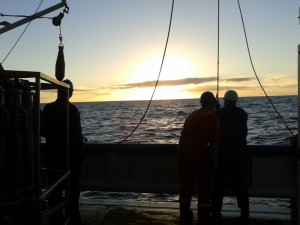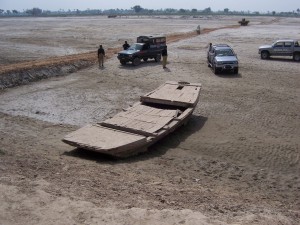Just like the Earth’s ocean-climate system itself, the climate of climate science is ever evolving and changing, both politically and scientifically. On the 21st of December 1872, HMS Challenger set sail from Portsmouth on a three year long voyage of discovery. The pioneering work that happened during those intrepid months aboard, laid the foundations for the climate science that happens today. I recently embarked upon a research cruise (or as we call them, a scientific campaign), and each time we sent the coring barrel 2 km – 3 km down into the abyss below and an hour or so later hauled our finds onboard, it was like unwrapping a Christmas present when we split open each core, due to the potential of new discoveries to come. So, I can only imagine the excitement each time the scientists aboard HMS Challenger cast their nets, or measured their next sample. It was during that very first oceanographic voyage that we learnt that basically, the chemistry of the world’s oceans was roughly (give or take) the same, we learnt how salty the oceans were and in the years that followed that cruise, the diversity of life in the oceans started to reveal itself. Even now, we discover new species as we sample further into the abyssal depths (http://www.coml.org/), highlighting how much we don’t know about a resource that is so precious to us.
But I digress… climate science has progressed in leaps and bounds over the past few decades and likely much further beyond the wildest dreams of those who participated in the HMS Challenger expedition, which was embarked upon over a century ago. Facilitated by step changes in the underpinning technologies and funding initiatives, we now have long-term monitoring programmes that aim to measure the current state of our oceans, we can combine remote satellite and radar data with ground-truthing measurements in the cryospheric (glacial) parts of our globe, we can assess future impacts by using highly sophisticated computer simulations, and we can test these by looking at past climate changes. These past climatic changes can be assessed by measuring proxies. We can use ice cores to tell us about past temperatures and atmospheric gas concentrations, we can use microfossils in the marine sediments to indicate past oceanic temperatures and salinity, and we can use tracers and sediment properties to better understand how oceanic circulation patterns differed from the present-day. We can use tree rings, lake proxies and cave records to reconstruct precipitation patterns, and we can also turn to geomorphology, sedimentology and geophysics to inform us of past ice limits. For the climate of the last millennium, further evidence can be found in archaeological remains, as well as in historic records, and for the past few decades, we can generate temperature series from instrumental measurements. By knitting together the information within these different disciplines, there is a thriving community focussed towards driving our understanding of all aspects of the Earth’s climate, and the Intergovernmental Panel on Climate Change (IPCC) and the EGU Climate Division: Past, Present and Future are key instruments to do exactly that.
Historic and instrumental records of climatic change demonstrate that global average temperatures have risen by 0.72 ºC since the 1950’s (IPCC, 2013) and that as a response to this, mountain glaciers, as well as the Greenland and Antarctic ice sheets are diminishing at an astonishing rate. According to the IPCC (2013), projected rates of increased atmospheric CO2 concentration suggests that by 2100 we might experience 0.5 – 4 ºC of further enhanced warming and 0.5 – 0.9 m of sea-level change. By 2050, we might expect an almost ice-free world. The EGU-CLIMATE blog aims to take you through a journey of discovery as to how we put all the pieces of the climate jig-saw puzzle together.


